|

Disney's Haunted Mansion, out now in theaters, sets out to be both scary and family-friendly. That's a difficult, sometimes contradictory combination, which mirrors the ambitions of the theme park attraction that inspired it. Warning: The following contains spoilers for the new Haunted Mansion movie. If you haven't seen it yet, you should steer clear now. The Haunted Mansion was one of the last rides that Walt Disney himself had a role in creating, though it went through several iterations before the Imagineers settled on the final hodgepodge design. Unable to decide whether to make the ride frightening or funny, the Imagineers opted for a noncommittal mixture of both. That's why we get some parts of the ride that are fearsome, like the hallway of knocking doors; some parts that are silly, like the "swinging wake" in the graveyard; and some parts that ride the line, like the iconic stretching room. That the ride manages to balance both is a small miracle, and it's something that both Haunted Mansion movies—this new one and the old, Eddie Murphy-led movie from 2003—struggle to replicate. The new movie does a better job than the old one, to be sure, and it errs on the side of being scarier, rather than funnier. The movie is at its best when it hews closer to its source material, repurposing disparate elements Madame Leota, Master Gracey, Constance Hatchaway, and the Hatbox Ghost into a single, unified narrative. Beyond that, though, it's also a Disneyland fan's dream come true as the movie is stuffed with references to the original Haunted Mansion ride, as well as other versions of the iconic experience at the company's parks worldwide. Here are 25 Easter Eggs and references we noticed in the new Disney's Haunted Mansion. See something we missed? Let us know in the comments.
1. The Right Angle
When we first see the mansion in the movie, it is from the same angle that we first see the Haunted Mansion in Disneyland if we were to approach it from Frontierland when entering the park. The filmmakers stir nostalgic memories by framing this, and other key shots, from a guest perspective.
2. Funny Tombstones
At Disneyland, the Haunted Mansion has multiple tombstones scattered across the grounds. On them, the guests can read humorous poems that allude to the deceased people's unfortunate demise. In the movie, these tombstones still have humorous couplets, but they are located in a crawl space beneath the house, where Mr. Crump buried the bodies of his victims.
3. Statue Busts
The statue busts that line the hallways are an iconic illusion in the Disneyland Haunted Mansion, and when Guests walk past them, they give the impression that they are turning their heads to follow. Other statue busts, like this one, are based on the more cartoonish busts in Walt Disney World's Haunted Mansion. They were added to the outdoor cemetery in 2011, as a way of enhancing the line queue heading into the attraction.
4. Master Gracey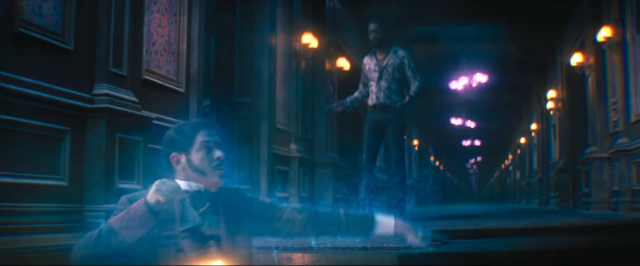
Master Gracey, who is in hiding from the villainous Mr. Crump, is a long-established character in Disneyland's Haunted Mansion, and he is widely accepted (first by fan rumors and later canonically) as the former owner of the mansion, officially known as Gracey Manor. His name is derived from that of Disney Imagineer Yale Gracey, who is responsible for many of the original ghosts' designs.
5. Sea Captain
The Sea Captain ghost in the movie is a reference to an early concept for the Haunted Mansion. This unused narrative would have originally revolved around a ghost sea captain who murders his young wife after she discovers he was a pirate, and subsequently hangs himself from the rafters.
6. The Stretching Room
This room is a replica of Disneyland's Haunted Mansion Stretching Room--a cleverly designed elevator that the Imagineers used to transport Guests under the Railroad and into the actual building that houses the ride. The four portraits on the wall, which elongate to show a more ghoulish subtext, were designed by Disney Imagineer Marc Davis, who pushed for the Mansion to be more lighthearted than frightening.
7. Portrait Obstacles
In the movie, the Stretching Room elongates and materializes deadly elements so that the characters cannot leave. These obstacles correspond to the stretching portraits' respective obstacles: quicksand, a crocodile, and kegs of dynamite.
8. Were-Tiger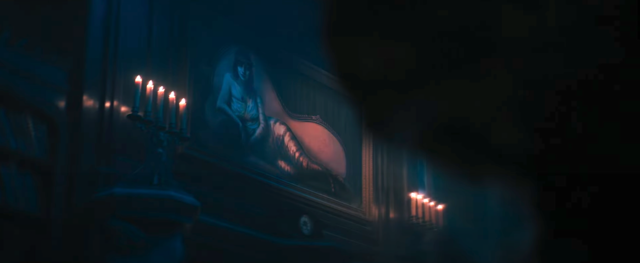
We can see a portrait over the fireplace, which reveals a young woman to be a tiger. This is based on a changing painting in Disneyland, which has the exact same effect. (In an earlier version of the painting, the woman originally turned into a panther--it was changed to a tiger in 2005.
9. Miss April/December
There is a picture on the stairwell that appears to be heavily inspired by another changing portrait, in which a young woman (April) metamorphosizes into an old woman (December). The characters later discover Madame Leota's seance room behind this painting.
10. Doom Buggy
The chair that transports Harriet out of the mansion is highly reminiscent of the "Doom Buggies" vehicles in the Disneyland ride, which transport the Guests on a looping conveyor belt through the Mansion's different rooms.
11. Subliminal Teeth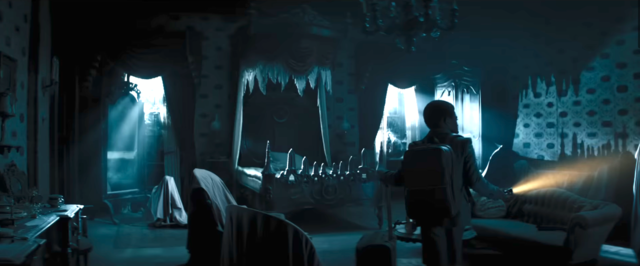
You'll notice that the bed curtains and bed frame give the impression of sharp teeth. There's lots of subliminal menace throughout both the movie and the ride, which recontextualizes ordinary objects with menacing undertones.
12. Trippy Staircases
While trying to find Travis, Ben runs into an optical illusion based on a lithograph print by M.C. Escher, named "Relativity." The Disney Imagineers added a similar room to the Walt Disney World Haunted Mansion in 2007.
13. Endless Hallway
The floating candelabra is a reference to the Endless Hallway sequence in the ride, in which we see a candelabra floating down a long hallway--an effect that uses mirrors to create an impression of infinity.
14. Hatbox Ghost
The Hatbox Ghost, which is the main antagonist in the movie, has long-established roots in the ride. It was part of the original experience when the Disneyland attraction opened in 1969, but it disappeared soon afterwards, because the optical illusion didn't work consistently. The low number of times that any Guest had actually seen the Hatbox Ghost created numerous rumors, with some people doubting it had ever been in the ride to begin with. The Hatbox Ghost made its triumphant return to the Disneyland ride in 2015. He's set to start haunting the Walt Disney World mansion later this year.
15. Knight in Shining Armor
The moving suit of armor in the movie is lifted from the Endless Hallway sequence in the ride. For a brief time in 1999, a live actor inhabited the suit of armor and would approach the Doom Buggies to frighten the Guests. However, Guests would instinctively attack the knight, and so Disney dropped the idea shortly afterwards.
16. Wallpaper
The mansion's wallpaper is taken from the Corridor of Doors sequence in the attraction. The incorporation of eyes into the design was intended to create the anxiety of being watched and scrutinized.
17. Look At The Time
The grandfather clock, which reads 13 o'clock, is lifted from the end of the Corridor of Doors sequence in the ride. It has teeth surrounding its face, which creates the subliminal impression of a demon, and its pendulum is a pointed devil's tail.

Madame Leota is played by Jamie Lee Curtis, a horror movie icon who played Laurie Strode in the Halloween movies. Later, when Madame Leota teaches Harriet the banishment incantation, part of it is lifted directly from the ride's opening spiel. It reads in full: "When hinges creak in doorless chambers,
And strange and frightening sounds echo through the halls.
Whenever candlelights flicker where the air is deathly still
That is the time when ghosts are present,
Practicing their terror with ghoulish delight."
19. Ballroom Sequence
Similar to the movie's opening shot, this shot of the ballroom sequence is also supposed to mirror the Guest's perspective in the Disneyland ride, which takes a bird's eye view to hide the use of a mirror optical illusion.
20. House Organ
The organist in the movie, who plays ghostly notes, is also lifted directly from the Ballroom Scene in the ride. Some interesting trivia: The organist in Disneyland is playing a real movie prop. It is the same organ as the one in the 1954 film 20,000 Leagues Under the Sea. The dueling ghosts from the ballroom scene are relocated elsewhere in the mansion for the movie, and they are given a backstory--they are brothers who both fire at the same time during a quarrel, killing each other.
21. Constance Hatchaway
The haunted bride in the movie has a backstory in the ride; she is Constance Hatchaway, a "black widow" who murders four husbands for their money. (The portrait in the Stretching Room, of an old woman perched on the tombstone of her late husband, is of Constance). In the ride's attic sequence, we see changing portraits of Constance with her different husbands--first with their heads, and then decapitated. We can see these same props during the movie, when Ben explores the attic and runs into Constance's ghost.
22. Crump Manor
The Crump Manor in the movie is based on the exterior of the Haunted Mansion in Walt Disney World. Unlike the Orleans plantation mansion in New Orleans Square, the Mansion in Disney World's Liberty Square is Dutch Gothic. The name "Crump" is taken from Disney Imagineer Rolly Crump, who worked on the Haunted Mansion in its early conceptual stages and came up with an idea for a "museum of the weird," which ultimately never came to fruition, although elements of it live on in Hong Kong Disneyland's Mystic Manor. Disney decided not to use an explicit ghost theme in Hong Kong, owing to Chinese superstition.
23. Caretaker Cameo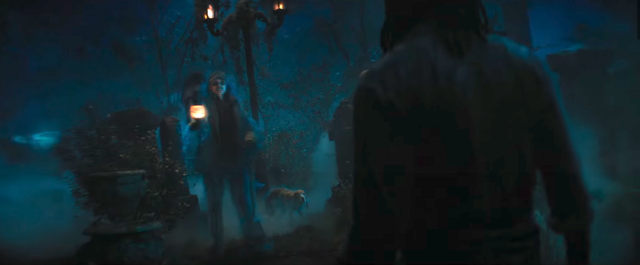
In the ride, the Caretaker and his Dog are the only two non-supernatural characters in the attraction. In the movie they are ghosts, just like the other 999 inhabitants of the mansion.
24. Grim Grinning Ghosts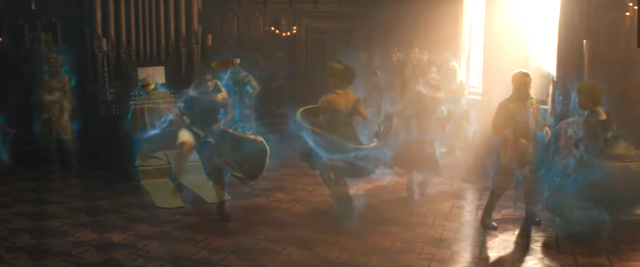
The attraction's signature song, "Grim Grinning Ghosts" is played throughout the movie as a recurring motif, but it is played for the first time in celebratory fashion at the end of the movie, along with its lyrics. They read in part: "When the crypt doors creak
And the tombstones quake
Spooks come out for a singing wake
Happy haunts materialize
And begin to vocalize
Grim grinning ghosts come out to socialize."
25. The Hitchhiking Ghosts
The three ghosts that Ben meets during his nightmare are the Hitchhiking Ghosts, which appear at the end of the ride, and appear to "follow you home," thanks to a mirror optical illusion. Their names are Phineas (the top-hatted one with the carpet bag), Ezra (the skeleton with the bowler), and Gus (the short bearded prisoner with the ball and chain). In the movie, unlike the attraction, there's a reason why they're hitchhiking; we can see their wrecked carriage right behind them (perhaps that's also why they died?).
|






























